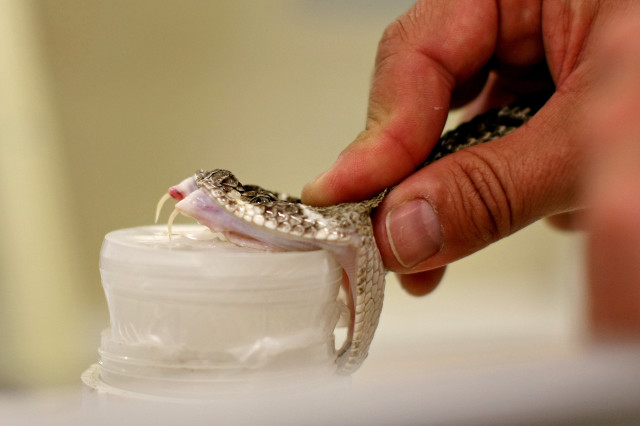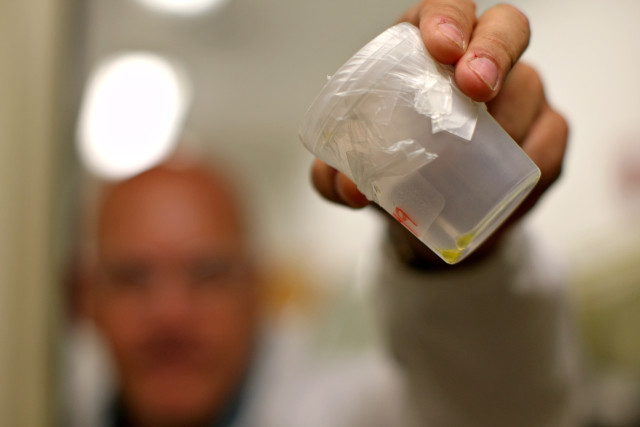Researchers Enlist Snake Venom in Anti-Cancer Campaign
By Samantha Ketterer
Reporting Texas

Mark Hockmuler, curator fo the Texas A&M Kingsville serpentarium, extracts venom from a western diamondback rattlesnake. Daulton Venglar/Reporting Texas
Snake venom isn’t usually the first thing that comes to mind when thinking of cancer research, but at Texas A&M University-Kingsville, the idea of saving lives through snake toxin isn’t considered wild at all.
Behind a glass window at the campus serpentarium, curator Mark Hockmuller, creeps up to a western diamondback rattlesnake, looking determined behind a pair of plastic goggles. He presses a curved hook into the snake’s neck to hold it steady and, after several seconds, he places his forefinger on its head. He isn’t wearing gloves. “It would hinder my sense of what he’s going to do,” he said.
Hockmuller slides the snake to a plastic cup, and its curved fangs bite down into a latex covering. Its tail sounds off like a maraca, as just a few drops of venom hit the bottom of the cup. Hockmuller’s finger stays in place while he extracts the deadly liquid – one wrong move could result in serious injury or death.
But there’s a good reason Hockmuller risks his life. The venom he collects is put to use in the university’s laboratories, where samples are used for scientific research. The end goal: to use the deadly toxins to save lives through the design of cancer-battling drugs.
At A&M’s Natural Toxins Research Center, which also houses the serpentarium, researchers test the snakes’ venom against different types of cancer cells, including various kinds of melanomas and carcinomas, hoping to find ways to block the cells’ growth. The center is the largest research facility of its kind in the country, housing both a research laboratory and the serpentarium that contains some 450 snakes, as many as 25 different species.
The idea is to create drugs that replicate the growth-blocking activity of the snake venom, said Peter Davies, the center’s co-director and a professor at the Institute of Biosciences and Technology at the Texas A&M Health Science Center.
“We’re looking to translate what we can discover with the venom, but ultimately translate it into what can be useful for people,” Davies said.
The research is done by isolating specific molecules in the venom and targeting them on specific cancer cell lines. The molecules can bind to various receptors on the cell’s surface, which allows them to enter the cell. If that happens, theoretically speaking, the venom can prevent the cancerous cell from growing.

Western diamondback rattlesnake venom destroys blood cells and tissues and causes internal hemorrhaging. A bite can be fatal if not treated in a timely manner. Daulton Venglar/Reporting Texas
The center has been conducting this type of cancer research since the 1970s. But back then, technology wasn’t as advanced, and the pool of snake venom to choose from was not nearly as large, said co-director Elda Sanchez, who holds a Ph.D. in toxicology.
Now, the center has hundreds of snakes from which to extract venom, compared to around 50 snakes in the 1990s, Sanchez said. The center has also seen a progression in its technological methods, which have increased the opportunity of making advancements in research.
One of the most important advancements, Sanchez said, is technology that enables researchers to determine “amino acid sequences,” or the chains that make up proteins in cancer cells. Knowing this can help researchers better target the cells.
The center employed some 20 faculty and students in pursuit of its research, which isn’t limited to any certain type of cancer. They typically spend about half of their time on cancer studies, Sanchez said. The rest of researchers’ time is mostly spent on cell cloning, stroke research, which also focuses on snake venom, and creating medicines to cure people who have been bitten by poisonous snakes.
The center’s operating cost for 2015 was $500,000, Sanchez said, most of which was funded by the National Institute of Health.
Sanchez said although the center has made progress, its studies have not yet made it past the initial testing phase into clinical trials.
“This is in a research stage obviously,” Sanchez said. “Cancer is extremely complicated, right? We can only say this venom has [certain effects] on these cancer cell lines.”
Sanchez said using snake venom in cancer research is only logical, since venom has a natural, destructive target on cells. To date, no drug based on venom research has ever been used to actually treat cancer, in Kingsville or any other U.S. testing site, Sanchez and Davies both said.
Although the research hasn’t led to any clinical success, Sanchez said it’s worth pursuing.
“I think we should always be looking to find alternate cures for various diseases,” she said.
For now, the search goes on.
“Our goal is to use the snake venom as a lead to give us new insights and strategies that can either be used to kill cancer cells … or to block the growth of blood vessels that tumors need to grow and flourish,” said Davies, the center’s co-director.
George Stancel, pharmacologist and executive vice president for academic and research affairs at the UT Health Science Center at Houston, said venom is more effective in killing cancer cells than in killing regular cells.
“There’s no doubt that it’s historically been a useful form of research,” he said. “There’s reason to expect that the more venom we purify, the more advances we can make.”
Davies said the public seems generally interested in their research because it contradicts what one might generally think about snake venom.
“People are really interested in the idea that something we initially think of as horrible could have some real value to society in the form of new strategies for treating important diseases,” Davies said. “We feel that this path that we’re following will and is opening up new avenues for developing new drugs.”